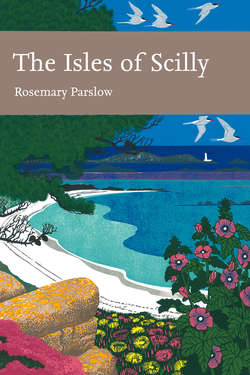Читать книгу The Isles of Scilly - Rosemary Parslow - Страница 50
PORTHS AND BAYS
ОглавлениеBecause part of St Mary’s straddles a sand bar there are two bays with sandy beaches, Porth Cressa on the south and Town Beach on the north within the Pool (harbour). Porth Cressa lies between the two headlands of Peninnis, the long promontory stretching to the south, and the Hugh, the hill surmounted by the Garrison with the town creeping up its flanks. Porth Cressa is one of the most accessible and popular bays with families and visitors staying locally, because of its proximity to the town and local amenities (Fig. 35). Although it is usually a sheltered bay, the area has proved extremely vulnerable when there are storms from the south. In the past the sea has broken through on a number of occasions and threatened to wash away the buildings (which are virtually only perched on the former sand dune) and eventually cut through into the Pool on the other side of the island. In recent years major defence works have been carried out along Porth Cressa beach to reinforce the sea bank and protect the town. There is perhaps little of great interest yet along the beach, due to the landscaping when the bank was restored, although arable weeds are reappearing in the flowerbeds and some of the sand-dune plants such as sea radish and yellow horned-poppy Glaucium flavum are colonising the beach defences. Town Beach has slightly more muddy sand, and is where all the mooring lines from the smaller boats in the harbour are stretched ashore.
There are several bays on the east coast of St Mary’s. Old Town Bay is quite rocky but with clear channels into the harbour, sheltered from all directions except southeast. The harbour is only accessible at high tide. Near the narrow sandy beach are patches of tree-mallow Lavatera arborea, smaller tree-mallow L. cretica, sea radish, white ramping-fumitory Fumaria capreolata and other plants
FIG 35. Porth Cressa, July 2006. (Rosemary Parslow)
that flourish in the disturbed sandy ground. The sea wall was rebuilt in 1996 after severe storms caused a great amount of damage.
Porth Minick is quite a small bay and has also had substantial sea defence works to reinforce the sea bank. One of the best stands of sea-kale Crambe maritima grows at the top of the beach, and I once saw an islander collecting leaves of the plants by the sack-load – whether to use as a vegetable or perhaps more likely to feed tame rabbits was not clear. Among the rocks at one end of the beach are clumps of house holly-fern Cyrtomium falcata growing in deep crevices where it has been established for many years among the boulders. Fortunately the beach works stopped just before reaching the fern.
Porth Hellick is a large inlet at the seaward end of the Higher Moors nature trail. There is a narrow sandy beach and below it a rocky bay with pools and shallows that attract many birds; at times rare waders will turn up to feed at low water. Between the reedbed around Porth Hellick Pool and the bay there is a narrow strip of tall grassland with wild angelica Angelica sylvestris, balm-leaved figwort and bracken. The bank of the Porth is densely planted with clumps of spiky rhodostachys Fascicularia bicolor, replacing the New Zealand flax Phormium sp. that formerly grew there to consolidate the low dune. The seaward side of the bank supports common dune plants, marram Ammophila arenaria, sea sandwort Honckenya peploides, sea-kale, yellow horned-poppy and oraches Atriplex spp. This is also a good place to look for the distinctive little striped nymphs of the lesser cockroach Ectobius panzeri. Greek sea-spurrey Spergularia bocconii used to grow near the small granite monument to Sir Cloudesley Shovell at the top of the beach, although it has not been seen there for many years, possibly due to the changes that have been made to the sea bank (recently Greek sea-spurrey has been re-found at other sites on the east coast of St Mary’s). The monument marks the spot where the ill-fated admiral’s body was first buried (it is now in Westminster Abbey) when it came ashore after his fleet foundered in the islands in 1707. Another very beautiful sandy bay on the east side of the island is at Pelistry, with its sparkling white sands and unsurpassed views towards Toll’s Island and a distant view of the Eastern Isles.
There are also sandy bays on the west coast of St Mary’s. Porth Mellon is on the edge of Hugh Town and popular for sailing and other activities. There is a degraded sand dune at the back of the bay with some typical species among the marram grass. The next small sandy bay is Thomas’s Porth, backed by narrow dunes and dune grassland. A little group of small bulb fields above the bay once
FIG 36. The coastal form of wall rue, with unusually thick and fleshy fronds. St Mary’s, June 2004. (Rosemary Parslow)
grew a crop of the original Sol d’Or narcissus. Among interesting arable species in these fields are fumitories Fumaria spp., small-flowered catchfly and masses of starflowers Tristagma uniflorum. One of the less common Carpobrotus species grows beside the footpath and Babington’s leek grows in the dunes. At Porthloo the grassland behind the dunes is used for boat standing and boat building; occasionally plants such as hairy buttercup Ranunculus sardous and arable weed species can turn up here due to the constant traffic and disturbance. Wall rue Asplenium ruta-muraria grows on a wall near here, the only place the fern is known on St Mary’s (Fig. 36). The fronds are unusually thick and fleshy, probably due to exposure to salt spray. Porthloo is also a geological SSSI, based on the Quaternary sedimentary deposits in the cliffs, the raised beaches, and organic material that includes pollen indicating former arctic tundra conditions in the palaeoclimate of the island.
